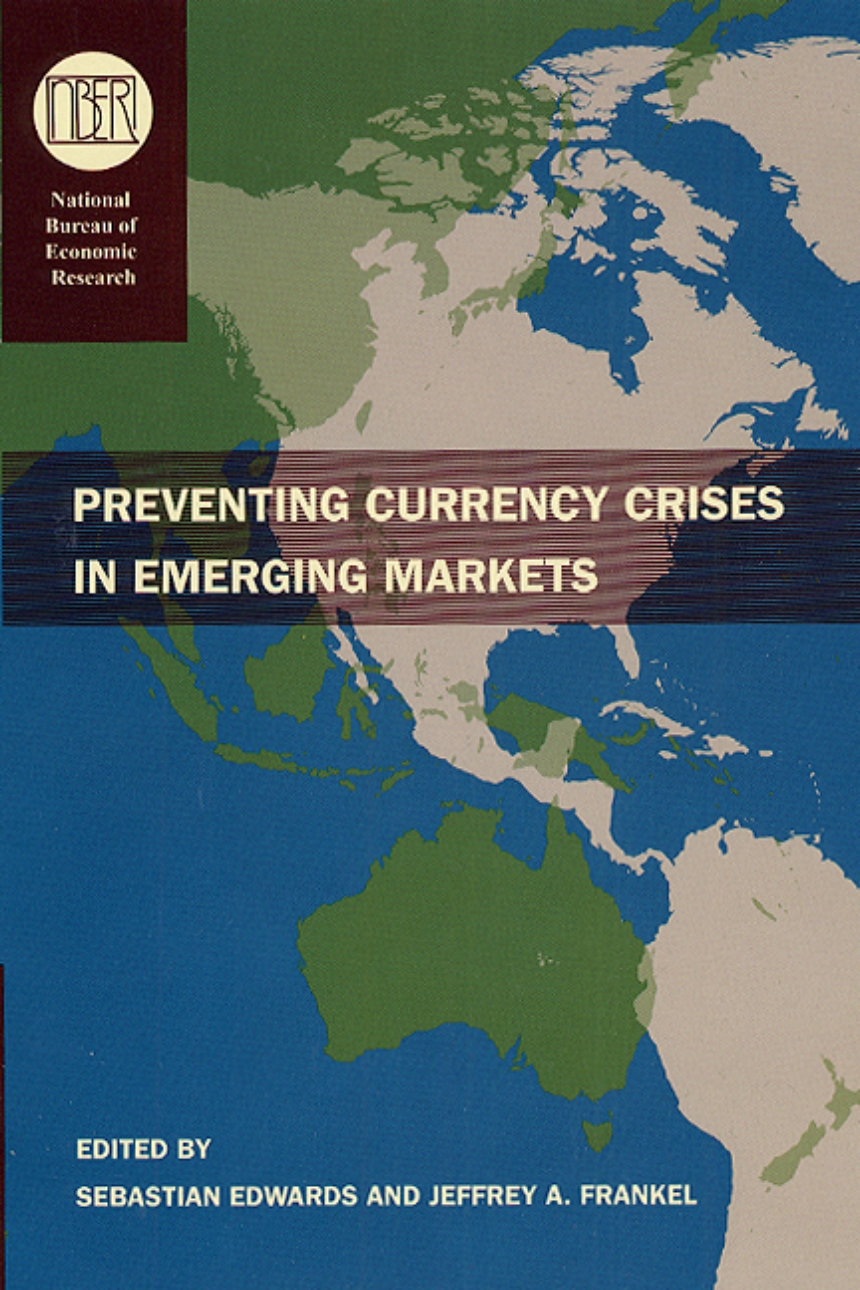Preventing Currency Crises in Emerging Markets
Economists and policymakers are still trying to understand the lessons recent financial crises in Asia and other emerging market countries hold for the future of the global financial system. In this timely and important volume, distinguished academics, officials in multilateral organizations, and public and private sector economists explore the causes of and effective policy responses to international currency crises.
Topics covered include exchange rate regimes, contagion (transmission of currency crises across countries), the current account of the balance of payments, the role of private sector investors and of speculators, the reaction of the official sector (including the multilaterals), capital controls, bank supervision and weaknesses, and the roles of cronyism, corruption, and large players (including hedge funds).
Ably balancing detailed case studies, cross-country comparisons, and theoretical concerns, this book will make a major contribution to ongoing efforts to understand and prevent international currency crises.
Topics covered include exchange rate regimes, contagion (transmission of currency crises across countries), the current account of the balance of payments, the role of private sector investors and of speculators, the reaction of the official sector (including the multilaterals), capital controls, bank supervision and weaknesses, and the roles of cronyism, corruption, and large players (including hedge funds).
Ably balancing detailed case studies, cross-country comparisons, and theoretical concerns, this book will make a major contribution to ongoing efforts to understand and prevent international currency crises.
720 pages | 88 line drawings, 139 tables | 6 x 9 | © 2002
National Bureau of Economic Research Conference Report
Economics and Business: Economics--International and Comparative
Table of Contents
Introduction
Sebastian Edwards and Jeffrey A. Frankel
I. The Current Account and Vulnerability to Crisis
1. Does the Current Account Matter?
Sebastian Edwards
Comment: Alejandro M. Werner
Discussion Summary
2. Are Trade Linkages Important Determinants of Country Vulernability to Crises?
Kristin J. Forbes
Comment: Federico Sturzenegger
Discussion Summary
II. International Financial Players and Contagion
3. What Hurts Emerging Markets Most? G3 Exchange Rate or Interest Rate Volatility
Carmen M. Reinhart and Vincent Raymond Reinhart
Comment: Joshua Aizenman
Discussion Summary
4. When Is U.S. Bank Lending to Emerging Markets Volatile?
Linda S. Goldberg
Comment: Simon Johnson
Discussion Summary
5. The Role of Large Players in Currency Crises
Giancarlo Corsetti, Paolo Pesenti and Nouriel Roubini
Comment: Jaume Ventura
Discussion Summary
6. Contagion: How to Measure It?
Roberto Rigobon
Comment: Enrique B. Mendoza
Discussion Summary
7. Credit, Prices, and Crashes: Business Cycles with a Sudden Stop
Enrique G. Mendoza
Comment: Joshua Aizenman
Discussion Summary
III. Capital Controls: The Malaysian Experience
8. Did the Malaysian Capital Controls Work?
Ethan Kaplan and Dani Rodrik
Comment: Liliana Rojas-Suarez
Discussion Summary
9. Malaysia’s Crisis: Was It Different?
Rudi Dornbusch
Comment: Michael P. Dooley
Discussion Summary
IV. Balance Sheets and "Crony Capitalism"
10. Negative Alchemy? Corruption, Composition of Capital Flows, and Currency Crises
Shang-Jin Wei and Yi Wu
Comment: Martin Feldstein
Discussion Summary
11. Domestic Bank Regulation and Financial Crises: Theory and Empirical Evidence from East Asia
Robert Dekle and Kenneth Kletzer
Comment: Paolo Pesenti
Discussion Summary
12. Dollarization of Liabilities, Net Worth Effects, and Optimal Monetary Policy
Luis Felipe Céspedes, Roberto Chang, and Andrés Velasco
Comment: Nouriel Roubini
Discussion Summary
13. Chaebol Capitalism and the Currency-Financial Crisis in Korea
Anne O. Krueger and Jungho Yoo
Comment: Jorge Braga de Macedo
Discussion Summary
14. Living with the Fear of Floating: An Optimal Policy Perspective
Amartya Lahiri and Carlos A. Végh
Comment: Eduardo Borensztein
Discussion Summary
15. Policy in an Economy with Balance Sheet Effects
Aaron Tornell
Comment: Charles W. Calomiris
Discussion Summary
V. Overview
16. A Primer on Emerging-Market Crises
Rudi Dornbusch
Sebastian Edwards and Jeffrey A. Frankel
I. The Current Account and Vulnerability to Crisis
1. Does the Current Account Matter?
Sebastian Edwards
Comment: Alejandro M. Werner
Discussion Summary
2. Are Trade Linkages Important Determinants of Country Vulernability to Crises?
Kristin J. Forbes
Comment: Federico Sturzenegger
Discussion Summary
II. International Financial Players and Contagion
3. What Hurts Emerging Markets Most? G3 Exchange Rate or Interest Rate Volatility
Carmen M. Reinhart and Vincent Raymond Reinhart
Comment: Joshua Aizenman
Discussion Summary
4. When Is U.S. Bank Lending to Emerging Markets Volatile?
Linda S. Goldberg
Comment: Simon Johnson
Discussion Summary
5. The Role of Large Players in Currency Crises
Giancarlo Corsetti, Paolo Pesenti and Nouriel Roubini
Comment: Jaume Ventura
Discussion Summary
6. Contagion: How to Measure It?
Roberto Rigobon
Comment: Enrique B. Mendoza
Discussion Summary
7. Credit, Prices, and Crashes: Business Cycles with a Sudden Stop
Enrique G. Mendoza
Comment: Joshua Aizenman
Discussion Summary
III. Capital Controls: The Malaysian Experience
8. Did the Malaysian Capital Controls Work?
Ethan Kaplan and Dani Rodrik
Comment: Liliana Rojas-Suarez
Discussion Summary
9. Malaysia’s Crisis: Was It Different?
Rudi Dornbusch
Comment: Michael P. Dooley
Discussion Summary
IV. Balance Sheets and "Crony Capitalism"
10. Negative Alchemy? Corruption, Composition of Capital Flows, and Currency Crises
Shang-Jin Wei and Yi Wu
Comment: Martin Feldstein
Discussion Summary
11. Domestic Bank Regulation and Financial Crises: Theory and Empirical Evidence from East Asia
Robert Dekle and Kenneth Kletzer
Comment: Paolo Pesenti
Discussion Summary
12. Dollarization of Liabilities, Net Worth Effects, and Optimal Monetary Policy
Luis Felipe Céspedes, Roberto Chang, and Andrés Velasco
Comment: Nouriel Roubini
Discussion Summary
13. Chaebol Capitalism and the Currency-Financial Crisis in Korea
Anne O. Krueger and Jungho Yoo
Comment: Jorge Braga de Macedo
Discussion Summary
14. Living with the Fear of Floating: An Optimal Policy Perspective
Amartya Lahiri and Carlos A. Végh
Comment: Eduardo Borensztein
Discussion Summary
15. Policy in an Economy with Balance Sheet Effects
Aaron Tornell
Comment: Charles W. Calomiris
Discussion Summary
V. Overview
16. A Primer on Emerging-Market Crises
Rudi Dornbusch
